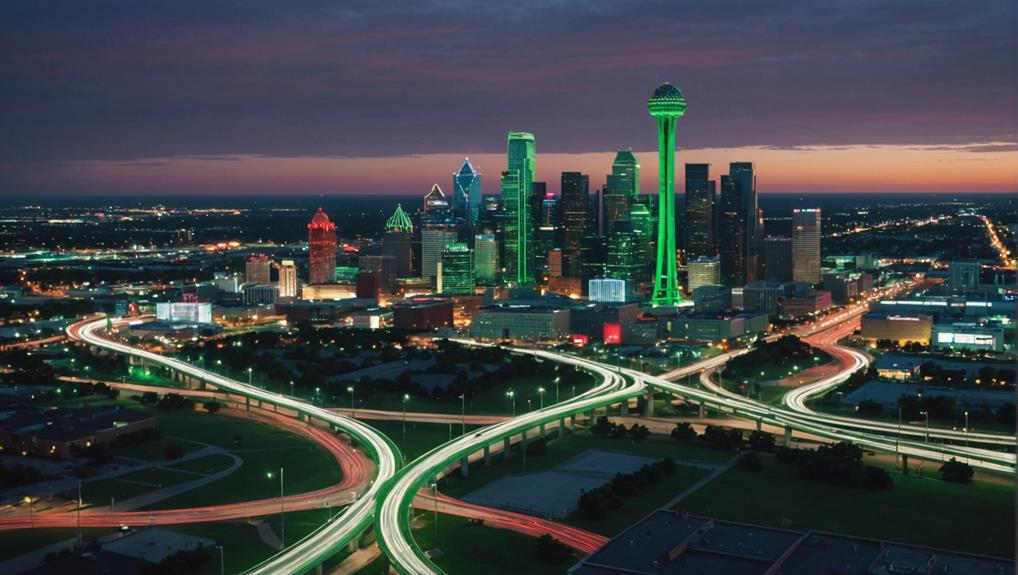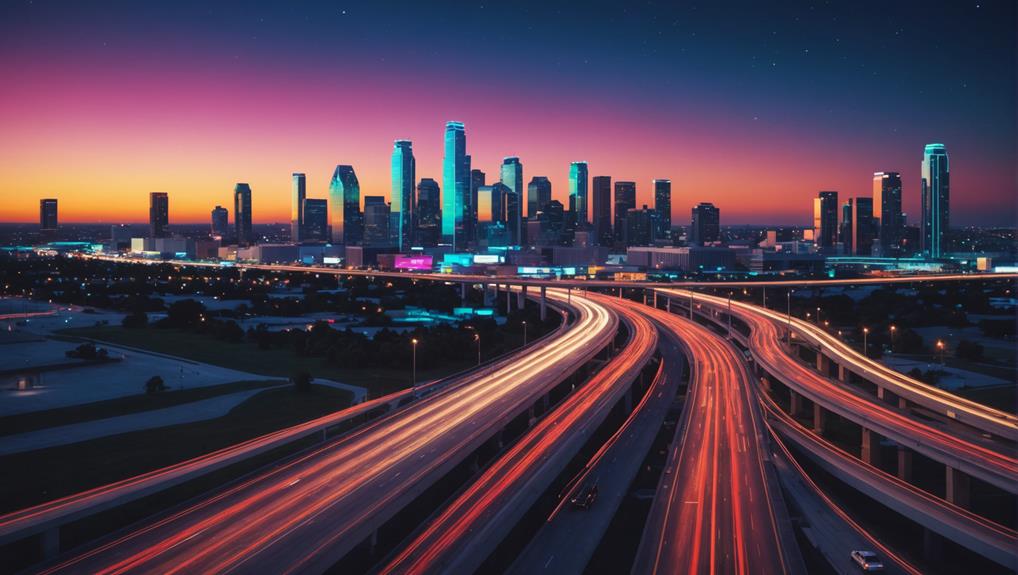As you navigate the busy streets of Dallas, you’re likely no stranger to the frustration of rush-hour traffic. You’ve probably wasted precious time stuck in traffic jams, wondering if there’s a better way to get from point A to point B. The good news is that there are strategies to help you avoid congestion and make the most of your commute. By understanding the city’s traffic patterns and leveraging the right tools, you can shave minutes – even hours – off your travel time. But which routes will get you there fastest, and how can you stay one step ahead of the traffic chaos?
Summary of Key Findings
- Use GPS navigation and real-time traffic updates to optimize route planning and sidestep congested roads in Dallas.
- Plan commutes during off-peak hours (9:30 am to 3 pm) to avoid traffic and minimize travel time.
- Identify peak traffic hours and try to avoid them using apps like Waze or Google Maps to find the most efficient routes.
- Consider alternative transportation options like carpooling, public transportation, or electric scooter rentals to reduce traffic congestion.
- Check for road closures or construction and plan routes in advance to minimize travel time and reduce stress.
Mastering Rush Hour Strategies
By understanding and adapting to Dallas’s unique rush hour patterns, you can optimize your daily commute and minimize time wasted in traffic.
Dallas’s rush hour peaks from 7 a.m. to 9:30 a.m. and again from 3 p.m. to 6:30 p.m., so it’s essential to plan accordingly.
You can avoid traffic by planning your commute during off-peak hours, typically between 9:30 am and 3 pm.
Time blocking can help you accomplish essential errands or tasks during peak rush hour, saving energy in the long run.
Navigating Alternative Transportation
As you seek to escape the gridlock, exploring alternative transportation options becomes essential to efficiently traversing Dallas’s congested streets.
You can consider carpooling or ride-sharing with colleagues to reduce the number of cars on the road and alleviate traffic congestion.
Alternatively, explore public transportation options like DART buses and trains, which offer an affordable and efficient way to navigate the city without contributing to traffic.
For shorter commutes, consider renting an electric scooter or bike. These are convenient and environmentally friendly alternatives to driving.
You can also promote telecommuting or remote work arrangements to reduce the need for daily commutes and minimize traffic impact.
Use Google Maps to find back roads that may save you time and stress, and plan routes that avoid busy intersections and highways during peak hours to optimize your work commute.
Optimizing Route Planning Techniques

To shave precious minutes off your daily commute, you can harness the power of GPS navigation and real-time traffic updates to optimize your route planning and sidestep congested roads.
You can find the most efficient routes and avoid traffic hotspots in Dallas by using apps like Waze or Google Maps.
Planning your route and checking for road closures or construction can also help minimize travel time and reduce stress.
Identify peak traffic hours, such as rush hour, and try to avoid them to reduce travel time and congestion substantially.
Staying Informed and Prepared
Stay one step ahead of Dallas traffic by checking the morning weather forecast to anticipate potential road shutdowns and having a backup plan ready.
If it’s a stormy day, prepare for delays and plan routes that avoid flood-prone areas.
To plan your route accordingly, familiarize yourself with seasonal events in Dallas, like game days at AT&T Stadium, Six Flags, and Rangers Ballpark. Check for road closures and traffic updates during these events and plan alternative routes to bypass congested areas.
Leaving early for work can also help you account for potential delays.
Stay informed about local conditions through traffic apps and maps to optimize your route and time of day.
Leveraging Technology and Efficiency

Integrating cutting-edge technology into your daily commute allows you to optimize your route and avoid traffic congestion in Dallas.
Utilize traffic apps like Waze or Google Maps to receive real-time updates and find the most efficient routes. Voice assistants like Siri or Alexa enable hands-free navigation, allowing you to focus on the road while receiving turn-by-turn directions.
Consider investing in a dashcam for added safety and potential insurance cost reductions. Use traffic management systems like smart traffic lights to optimize traffic flow and reduce congestion.
Use parking apps like ParkMe or SpotHero to find available parking spots, reducing time spent circling quickly. By leveraging these technologies, you can easily bypass traffic and navigate Dallas roads.
Frequently Asked Questions
What Is the Best Time of Day to Drive Through Dallas?
When planning your drive, you’ll want to know the best time to avoid traffic congestion.
Peak rush hour is from 7 a.m. to 9:30 a.m. and 3 p.m. to 6:30 p.m., so it’s best to avoid these times.
Instead, consider leaving early, around 2 hours before peak hours, or traveling during off-peak hours, like 9:30 am to 3 pm, for faster travel times and less stress.
Where Should I Drive in Dallas?
When traversing Dallas, you should avoid highways during peak hours and opt for back roads instead.
Use GPS navigation and traffic apps like Waze or Google Maps to find the most efficient routes.
To pick up I-20, take alternative roads like Hillsboro to Weatherford, and plan your route in advance to avoid construction zones and road closures.
Is Driving in Dallas Difficult?
You’re probably wondering if driving in Dallas is difficult.
The answer is that it can. You’ll likely face congestion, with rush hour traffic peaking from 7 a.m. to 9:30 a.m. and from 3 p.m. to 6:30 p.m.
However, you can minimize stress by planning your commute during off-peak hours, leaving early or late, and using traffic apps.
Flexible work arrangements can also help you avoid traffic difficulties.
Is Traffic in Dallas Bad?
You’re wondering if traffic in Dallas is bad?
Let’s look at the numbers.
Dallas is the 10th most congested city in the US, with drivers spending an average of 145 hours per year stuck in traffic.
That’s a whopping $1,300 per year in fuel, time, and 30 minutes per day spent idle.
With the city’s rapid growth, it’s no surprise that traffic congestion is a major issue.
Conclusion
Reliable Transportation Services in Dallas
By integrating the abovementioned strategies, you’ll be well-equipped to traverse Dallas‘ congested roads.
Mastering rush hour tactics, piloting alternative transportation, optimizing route planning, staying informed, and leveraging technology will become second nature.
You’ll minimize travel time and reduce stress with real-time traffic updates and GPS navigation.
Doing so saves an average of 30 minutes per day, translating to 120 hours per year – time better spent on more productive pursuits.
DFW Taxi Express offers a range of transportation services, including taxi cabs, limousines, and airport services, providing a convenient and reliable solution to navigate Dallas’ traffic.
With a high-quality fleet, 24/7 customer support, and promptness and punctuality, DFW Taxi Express ensures a hassle-free travel experience.
Additionally, their low rates, free price checks, and advanced online booking availability make them ideal choices for all your transportation needs in Dallas.



